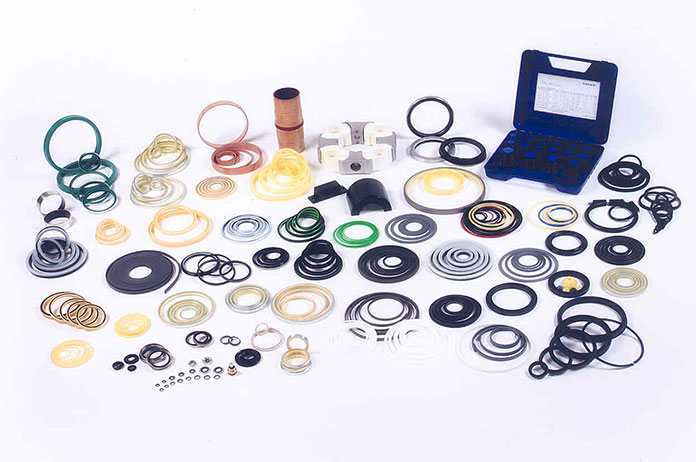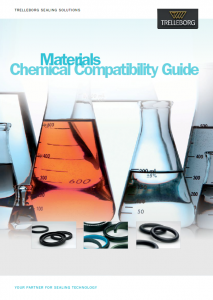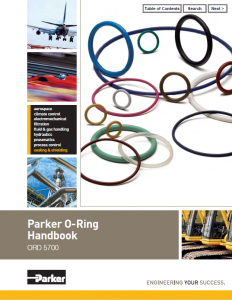How picking the right elastomeric hydraulic seal material is more than just chemistry and a catalogue.
- Use a seal material catalogue
- Useful elastomer materials
- What to watch out for
- Talk to an applications engineer
After 30 years, Sarum Hydraulics knows quite a lot about seals and sealing, but you never really know enough. With a big range of products and applications, we learn something new about sealing almost every day.
So where do you start in our world if you need to pick the right compound to suit your fluid? You could be replacing an existing o-ring and don’t know what compound it is. Maybe a customer has asked whether your product can be fitted with seals for a odd ball fluid. Or you are designing a new unit and are about to delve into finding a seal from catalogues.
Why bother when Nitrile does almost everything, doesn’t it? No, look at the compatibility tables and you see not. The wrong seal compound will either fail prematurely by leaking or damage the system. You risk seal swelling, disintegration or ultimately system failure. What a waste of time over a few pence. Or pay a few pence more and you have a “better” compound but maybe subject to limitations that you need to know about.
Sorting out the right compound or compounds for the job is the priority. Is there just one suitable material or lots? Which seems the best fit from what you know? That is a good stating point. Then is the time to look in the seal catalogues, talking to a distributor or designing the equipment. Needless to say that picking a seal from a catalogue, only to find that it is not available in Viton is a waste of time, although don’t despair. There can be a way through.
Use a seal material catalogue
For the best material, start with chemistry and seal compatibility. There are great resources on the web. We like the Trelleborg sealing materials catalogue or Parker Hannifin’s master guide. You might have your own favourite.
Homing in on the right material for the job, specifying the right compound or list of compounds from a catalogue or seal supplier is half the job. The other half is deciding on the pluses and minuses of materials, working out what would be a good choice and what not the best. There is more to it than just picking something from a catalogue. Materials have their own peculiarities. Chemistry is only half the story. You might have to live with a material for years. Pick a lemon and life can be far too much like hard work. How many manufacturers offer a whole range of seal compounds as catalogue parts then find that when somebody orders them, they can’t get the seals? Or by not volunteering “special seals available”, are you missing out on potential orders?
Useful elastomer materials
Let’s start with compounds, as you would find them listed in the compatibility tables.
Nitrile (or Buna n) is a mighty handy material. Wide compatibility and remarkably low temperature operation. Probably first choice on o-rings for mineral oil. You will start with medium nitrile and probably 70 shore hardness. Even generic nitrile can be formulated in different compounds.
As well as the compound, keep in mind to quote hardness (or “durometer”) on any elastomeric material. If the designer has run with a certain shore durometer or hardness, vary at your peril! In nitrile, 70 shore will be very common, 90 shore available and other durometers like 60 shore more specialist.
Fluorocarbon (Chemours “Viton”) costs more than nitrile, has wider chemical compatibility and many manufacturers fit it as standard. The one downside is that its lower temperature limit is only -20OC, not the -40OC of nitrile. With the amount of equipment used in cold parts of the world, maybe it is worth pausing for thought before making it standard.
Ethylene propylene (EPDM) is widely used for hot water and steam. EPDM for phosphate ester oils like Skydrol will be peroxide cured EPDM, which is not the same thing. Beware!
PTFE (as in white virgin PTFE) can be brilliant for static sealing. It is amazingly inert on almost any fluid, but flows to a shape. There is very, very little spring in it, so it is unsuitable for dynamic sealing unless you make it into a lip seal with spring or an elastomeric material energising it. You are then back to selecting the right elastomer. Virgin PTFE will flow, hence be wear prone or likely to lose its profile in a dynamic application. I think the strongest application is static sealing using PTFE o-rings. Virgin PTFE anti-extrusion or backup rings are also a massive application for the material, although these are preventing extrusion, not doing the sealing.
Filled PTFE is a very powerful material. Manufacturers like Claron or Trelleborg (amongst lots of others) fill it with powders such as carbon, bronze or glass to provide enhanced wear resistance along with inherent low friction. Sealing elements are machined from the material then in dynamic applications are energised with elastomeric elements or springs. Note these are machined seals rather than moulded. More later, as this is a key point.
Polyurethane (PU) is a useful material. It is incredibly tough. Normally moulded, but the likes of DMR and Seal jet seems to do particularly well with it as a machined seal. Keep in mind a subtlety in that one type of PU does not like water.
Sarum is a fan of Ultra High Molecular Weight Polyethylene (UHMWP). It is machined to make seals and has some big pluses. The one downside is that it is a bulk produced material and the chemistry can be complicated. We had one problem in 30 years with stability, but never the less a concern.
Silicone is used in certain industries like food, but maybe not so common in mainstream hydraulics. The mechanical strength can be an issue. Don’t confuse this with Fluorosilicone, which is a special grade used in aerospace, having resistance to fuels and very low temperature properties.
What to watch out for
Formulations change over time
Blends have had to change for environmental reasons.
Just be aware that some constituents of elastomers are no longer used. Manufacturers have had to reformulate their offerings. Not many people would revalidate their seal compounds let alone know that the formulation had even changed. It is unlikely to be a problem, but just could be worth keeping in mind.
Specialist compounds
Beware of “specialist”. Know any special requirements, as it will matter.
Always be careful of special compounds, or what turns out to be a special compound after the event. For example, if somebody asks for low temperature nitrile, I think you may struggle to find stock sizes and if you have to start getting them moulded you are in for an enormous amount per seal plus a certain lead time. The reality is that moulders have to buy in a quantity of raw material and set up the job. Similarly if somebody asks for seals approved (as opposed to suitable) for potable (drinking) water, the alarm bells should ring. WRAS approved seals will be invariably specially moulded at a high price if you are buying small numbers. Yes, if you are moulding millions, the price may well be next to nothing. It is a quantities game. Note “moulding’ economics are different to “machining”. See later.
Shelf life
Shelf life is important.
As with any elastomeric product, be aware of shelf life. Don’t be fobbed off with old seals. If you buy in a reasonable quantity with a recent cure, after a year they are “getting on” and some of your customers will not want them in the supply chain. Feel free to specify a cure date such as “moulded within the last three quarters” or “95% of shelf life remaining.” Do be aware that British Standard Shelf life figures on different compounds can differ from US standards, so do the homework. Factor in the need to turn over (sell) or throw away your seal stocks. Store them in black light-tight bags, as the UV does degrade elastomers. Labelling them and operating a “first-in, first-out” (FIFO) inventory system is a must.
Machined seals
Moulded versus machined seals.
Finally, let’s bottom out this fundamental difference between moulded and machined seals. We should also touch on a “generic” design where lots of people make a seal for the same groove and unique seals which only one supplier makes. You can make a clever or disastrous choice here.
A moulded seal uses a mould tool to produce a design owned by the seal manufacturer. If they are making thousands or millions, the cost is very low although the selling price may not be so. The manufacturer will have to buy in a certain amount of elastomer with a sell by date on it and will mould seals for stock. If they have run out, you could be waiting awhile for delivery and if you are fussy on cure dates, you may be unable to buy “recent cure” if there are thousands of “old” seals in stock. That is the downside of seals unique to one manufacturer. If the same seal is available from more than one manufacturer, that is a big plus for us at Sarum when designing a new product.
Moulded seals can be produced in small numbers at high cost. This is quite common in aerospace and defence. Also keep in mind that because shrinkage is different for various materials, you cannot assume that the mould that somebody has for one compound will be suitable for another.
If you move away from moulded seals to machined seals, then the economics change. Some materials like PTFE have to be machined. These seals will (by rights) be more expensive than cheap moulded rubber seals. The other interesting process, of which we are fans for the right application, is machined rubber and other elastomers. Yes, it can be done! DMR seals are our first choice here. Sealjet is another provider. These seals are going to be more expensive than cheap moulded seals on larger quantities, but they can get round the hassle of being unable to obtain a moulded seal to fit a certain groove or a moulded seal in an odd compound. A massive number of profiles and materials are available. For example, DMR will supply peroxide cured EPDM seals which is certainly amazingly useful if a moulder simply does not do them.
Talk to an applications engineer
If you have done your background work on your preferred seal compounds, then is the time to talk to an Applications Engineer or your seal supplier. Have all your facts to hand. Pressure, fluid, temperature, number of cycles, speed, environment and so on. Write down and communicate to the supplier all known conditions.
This has been a brief round up from what we have learnt about elastomer seal materials, over thirty years. Tell us what you have learnt. As usual, feel free to comment, even if something is wrong.
For years, people have used our Sarum Hydraulics Micropac hand pumps and pressure test equipment for all manner of fluids and conditions requiring all sorts of seals. Talk to us on 0044 1722 328388 or look at www.sarum-hydraulics.co.uk. Know exactly what you want? Buy on-line on www.pumpshoppro.com.






Leave A Comment